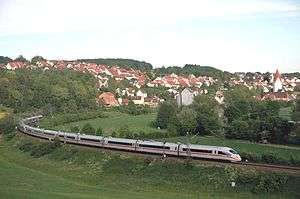Portion working
In rail terminology, portion working refers to the operational practice of coupling two or more passenger trains together over common sections of their respective routes, but otherwise operating the trains separately.[1][2] This allows multiple trains to use the same path over parts of the network where limited capacity is available.

Typically, the common sections will be the busiest parts of the totality of the routes covered by a portion working arrangement.[2]
History
The practice of portion working has been followed for a long time on the third rail network of lines in the South East of England, and has been more widely practised in continental Europe.[1]
Elsewhere in the United Kingdom, the practice has been less common, because of a general reluctance to design the necessary modern signalling systems, and because of legal constraints on competition between operators.[1]
Possible combinations
A variety of portion working combinations is possible. For example:
- two trains may each depart from separate termini, be coupled together en route, and arrive at their single destination together;
- or vice versa: a pair of trains may depart together from the same terminus, be separated en route, and then continue to separate destinations;
- two trains may each depart from separate termini, be coupled together, and later separated, en route, and then continue to separate destinations;
- a train may depart from a terminus, be coupled en route to another train departing from the point where the coupling occurs, and then the two trains will continue together to their single destination, thus providing a longer train for a busier portion of the route (or vice versa).
- a train may depart from a terminus, and divide at a station en route, with both portions then continuing to the same destination, but the first running an express stopping pattern, and the second part stopping more frequently. In the reverse of this, the second portion is the faster of the two, catching up the slow train at the point where they join.
Issues
For portion working to be successful, the operator may need to address many issues. For example:
- locations for (un)coupling must be identified and designed;
- the best combinations of services must be carefully considered;
- even with optimal operational arrangements (un)coupling takes time;
- portion working can transfer disruption from one section to the wider network.[2]
References
- "The Potential for Increased On-Rail Competition" (PDF). Renaissance Trains/Office of Rail Regulation UK. Retrieved 15 February 2013.
- "Further written evidence from Jonathan Tyler, Passenger Transport Networks (HSR 138A)". House of Commons. Retrieved 15 February 2013.